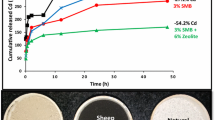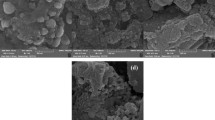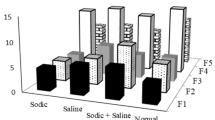Abstract
Heavy metal contamination in agricultural soils has become a serious environmental concern due to their generally high mobility and toxic effects on plants and food security. An incubation study was conducted to assess the effectiveness of biochar (BC), zeolite (ZE) and rock phosphate (RP) stabilizers on the immobilization of cadmium (Cd) in contaminated soils. Various extraction techniques were carried out: a sequential extraction procedure, the European Community Bureau of Reference (BCR), the toxicity characteristics leaching procedure (TCLP) and extraction with ammonium nitrate. In addition, Cd adsorption by these materials was observed using Langmuir and Freundlich isotherms. The results showed that with an increase in soil pH the exchangeable fraction of Cd in soil was significantly reduced by 28%–29.4%, 9%–13% and 4%–14% for BC, ZE, and RP, respectively. According to the Langmuir adsorption isotherm, BC-amended soil showed a higher adsorption capacity (Qm) of Cd from 8.38 to 19.85 mg g−1. Overall, BC offered better results when compared to other amendments.






Similar content being viewed by others
References
Adriano DC (2001) Trace elements in terrestrial environments, 2nd edn. Springer, New York
Ahmad M, Lee SS, Lim JE, Lee S, Cho JS, Deok HM, Hashimoto Y, Ok YS (2014) Speciation and phytoavailability of lead and antimony in a small arms range soil amended with mussel shell, cow bone and biochar: EXAFS spectroscopy and chemical extractions. Chemosphere 95:433–441
Bashir S, Hussain Q, Akmal M, Riaz M, Hu HQ, Ijaz SS, Iqbal M, Abro S, Mehmood S, Ahmad M (2017) Sugarcane bagasse-derived biochar reduces the cadmium and chromium bioavailability to mash bean and enhances the microbial activity in contaminated soil. J Soils Sediments. https://doi.org/10.1007/s11368-017-1796-z
Bashir S, Zhu J, Fu Q, Hu HQ (2018) Cadmium mobility, uptake and anti-oxidative response of water spinach (Ipomoea aquatic) under rice straw biochar, zeolite and rock phosphate as amendments. Chemosphere 194:579–587
Chen HM, Zheng CR, Tu C, Shen ZG (2000) Chemical methods and phytoremediation of soil contaminated with heavy metals. Chemosphere 41:229–234
Chen SB, Xu MG, Ma YB, Yang JC (2007) Evaluation of different phosphate amendments on availability of metals in contaminated soil. Ecotoxicol Environ Saf 67:278–285
China Environmental Quality Standard for Soil (GB15618-1995) (1995) China National Standardization Management Committee, China, Beijing
Jiang J, Xu RK, Wang Y, Zhao AZ (2008) The mechanism of chromate sorption by three variable charge soils. Chemosphere 71:1469–1475
Jiang TY, Jiang J, Xu RK, Li Z (2012) Adsorption of Pb(II) on variable charge soils amended with rice-straw derived biochar. Chemosphere 89(3):249–256
Lehmann J, Rillig MC, Thies J, Masiello CA, Hockaday WC, Crowley D (2011) Biochar effects on soil biota—a review. Soil Biol Biochem 43:1812–1836
Lu RK (1999) Analytical methods for soil agrochemistry. Chinese Agricultural Science and Technology Publishing House, Beijing (Chinese)
Lu K, Yang X, Shen J, Robinson B, Huang H, Liu D, Bolan N, Pei J, Wang H (2014) Effect of bamboo and rice straw biochars on the bioavailability of Cd, Cu, Pb and Zn to Sedum plumbizincicola. Agric Ecosyst Environ 191:124–132
Mehmood S, Rizwan M, Bashir S, Ditta A, Aziz O, Yong LZ, Dai Z, Akmal M, Ahmed W, Adeel M, Imtiaz M, Tu S (2017) Comparative effects of biochar, slag and ferrous–Mn ore on lead and cadmium immobilization in soil. Bull Environ Contam Toxicol. https://doi.org/10.1007/s00128-017-2222-3
Mignardi S, Corami A, Ferrini V (2012) Evaluation of the effectiveness of phosphate treatment for the remediation of mine waste soils contaminated with Cd, Cu, Pb, and Zn. Chemosphere 86:354–360
Mohamed I, Zhang G, Li Z, Liu Y, Chen F, Dai K (2015) Ecological restoration of an acidic Cd contaminated soil using bamboo biochar application. Ecol Eng 84:67–76
Oste LA, Lexmond TM, Van Riemsdijk WH (2002) Metal immobilization in soils using synthetic zeolites. J Environ Qual 31:813–821
Park JH, Choppala GK, Bolan NS, Chung JW, Chuasavathi T (2011) Biochar reduces the bioavailability and phytotoxicity of heavy metals. Plant Soil 348:439–451
Rauret G, Lopez-Sanchez JF, Sahuquillo A, Rubio R, Davidson C, Ure A, Quevauviller P (1999) Improvement of the BCR three step sequential extraction procedure prior to the certification of new sediment and soil reference materials. J Environ Monitor 1:57–61
Schlichting E, Blume HP, Stahr K (1995) Bodenkundliches Parktikum. Blackwell, Berlin
USEPA (1992) EPA method 1311. TCLP-toxicity characteristic leaching procedure. In: Test methods for evaluating solid waste, 3rd edn. Environmental Protection Agency, Washington
Usman ARA, Kuzyakov Y, Lorenz K, Stahr (2006) Remediation of a soil contaminated with heavy metals by immobilizing compounds. J Plant Nutr Soil Sci 169:205–212
Xu X, Cao X, Zhao L, Wang H, Yu H, Gao B (2013) Removal of Cu, Zn, and Cd fromaqueous solutions by the dairymanure-derived biochar. Environ Sci Pollut Res 20:358–368
Yuan JH, Xu RK, Zhang H (2011) The forms of alkalis in the biochar produced from crop residues at different temperatures. Bioresour Technol 102:3488–3497
Zhu R, Yu R, Yao J, Mao D, Xing C, Wang D (2008) Removal of Cd2+ from aqueous solutions by hydroxyapatite. Catal Today 139:94–99
Acknowledgements
The study was financially supported by National Sci-Tech Support Plan of China (2015BAD05B02).
Author information
Authors and Affiliations
Corresponding author
Rights and permissions
About this article
Cite this article
Bashir, S., Rizwan, M.S., Salam, A. et al. Cadmium Immobilization Potential of Rice Straw-Derived Biochar, Zeolite and Rock Phosphate: Extraction Techniques and Adsorption Mechanism. Bull Environ Contam Toxicol 100, 727–732 (2018). https://doi.org/10.1007/s00128-018-2310-z
Received:
Accepted:
Published:
Issue Date:
DOI: https://doi.org/10.1007/s00128-018-2310-z




